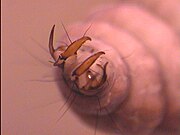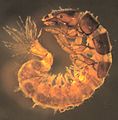Order Guide
| Work in progress, expect frequent changes. Help and feedback is welcome. See discussion page. |
Contents
Our approach
Relatively few invertebrate orders occur in freshwater, fewer occur commonly, and even fewer are common in streams. This guide ranks most orders by likelihood that you'll ever see them. This approach is different than a traditional key and makes no attempt to be comprehensive. If you need to cover every taxonomic group, then one of the very many excellent published keys is still a better approach.
List of common freshwater orders
Insect orders
Diptera: true flies
Fly larvae lack true jointed legs and this characteristic is enough to distinguish them from other insects in streams. Many dipterans have prolegs that lack hardened sclerites and joints and tend to be the same color as the insect's body (Figs 1 & 3). Real insect legs are segmented, have claws, and are attached only to the thorax (front end behind the head); if you find real legs then you did not find a dipteran.
- Commonly collected aquatic Diptera. Click to zoom in
Trichoptera: caddisflies
A single pair of anal claws at their tail end (Fig 4) sets caddisfly larvae apart from other aquatic insects. Many caddisflies are found in cases that can help with identification and should be kept in samples. Some fly larvae and aquatic moths also make cases but lack anal claws. Caddisflies in the genus Rhyacophila have particularly spectacular and obvious anal claws while those in the family Hydropsychidae may be partly hidden among hairs.
- Commonly collected Trichoptera. Click to zoom in
*Ephemeroptera: mayflies
Most mayfly nymphs have three 'tails' or cerci at the back end and one claw on each foot. There is a commonly collected genus that has just two tails.
*Plecoptera: stoneflies
Stonefly nymphs always have two 'tails' or cerci and two claws per foot. These characteristics are shared with the larvae of predatious diving beetle that are less frequently collected in streams. Stoneflies have compound eyes and highly segmented tails; both characteristics lacking in diving beetles.
- Coleoptera: beetles. Unfortunately there are really no convenient characteristics that quickly identify aquatic beetle larvae. Adult aquatic beetles are easier in that they have the paired hardened wing covers or elytra typical of all adult beetles.
- Odonata: in two suborders
- Anisoptera: dragonflies
- Zygoptera: damselflies
- Megaloptera: dobsonflies, alderflies, and fishflies
- Lepidoptera: moths
- Hemiptera: true bugs. These insects have a single, piercing mouthpart that is frequently directed back ventrally along the mid-line of the body. They are more common in ponds than in streams, but we do frequently find water striders that inadvertently end up in benthic samples.
Non-insect arthropod orders
- Amphipoda - Scuds are easily distinguished from other crustaceans in that they are laterally compressed - or flattened side-to-side if you prefer.
- Decapoda - Freshwater crustaceans bearing claws! In Vermont we frequently sample crayfish. Our Puerto Rican partners regularly collect freshwater crabs and shrimp.
- Isopoda - In contrast to the amphipods (above), isopods are dorso-ventrally flattened.
- Collembola - Springtails are non-insect hexapods. There are springtails associated with aquatic habitats and frequently the terrestrial species are found on the surface film. We find springtails in fewer than 5% of our samples but they are common enough to be worth a mention.
Mollusks
- Class Bivalvia - We collect three types of clams and a mussel. The clams are native pea clams and fingernail clams, along with the invasive Asian clam (Bronx and Puerto Rico so far). We find zebra mussels in Lake Champlain.
- Class Gastropoda - Snails are important freshwater organisms although less important in streams than in lakes and ponds.
Taxonomy
For the most part we have provided orders on this page. In some cases we went with more familiar classes (Gastropoda for example). All of the taxonomic information is based upon the Integrated Taxonomic Information System and we make every effort to keep the site current and consistent with the ITIS taxonomic standards.







